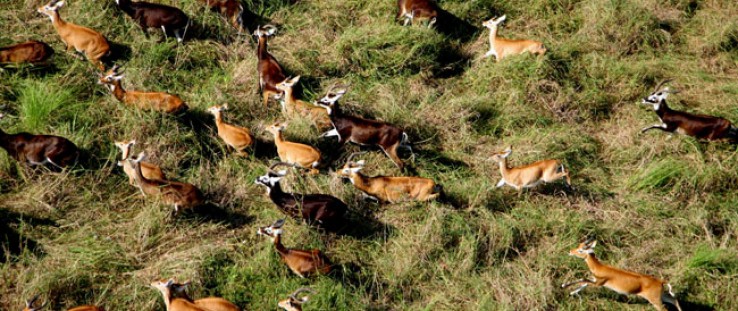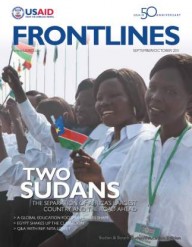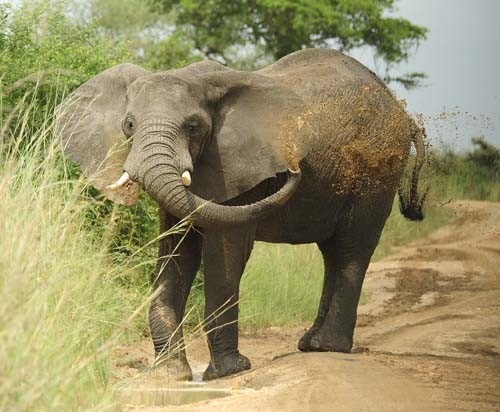 A herd of white-eared kob runs across an expanse of what is now South Sudan.
Paul Elkan, Wildlife Conservation Society
A herd of white-eared kob runs across an expanse of what is now South Sudan.
Paul Elkan, Wildlife Conservation Society
 A herd of white-eared kob runs across an expanse of what is now South Sudan.
Paul Elkan, Wildlife Conservation Society
A herd of white-eared kob runs across an expanse of what is now South Sudan.
Paul Elkan, Wildlife Conservation Society
While the people around them battled in Sudan’s 22-year war, the white-eared kob followed the seasonal migration corridors that their ancestors likely pounded for centuries. And that is what saved their lives.
Elephants, giraffe, buffalo, and antelope species like the white-eared kob have roamed South Sudan’s bucolic regions in vast numbers for years. But it wasn’t until a USAID-backed mapping project – that began in 2007 and whose results were published in 2010 – that anyone knew for certain that those animals survived a war that killed an estimated 2 million people.
Many did. Now the challenge is keeping them alive.
“The irony is that, during the war, some of the animal natural resources actually fared OK,” said David Gosney, team leader for economic growth at USAID/South Sudan. “But as South Sudan starts to develop, the threats are going to increase.”
Now that South Sudan is a newly independent country, it is facing monumental challenges. And while protecting wildlife may not seem like a top priority compared with other weighty issues, the subject has nonetheless attracted high-level interest – and support.
“South Sudan relies almost entirely on oil revenue to fund its budget and all its expenditures,” Gosney said. “Over time they really need to capture and develop their resources in other areas, and this includes South Sudan’s rich biodiversity.”
On July 6, just three days before the country celebrated its independence, USAID, the Wildlife Conservation Society, and the South Sudan government opened new headquarters for Badingilo National Park in Central and Eastern Equatoria, just two hours’ drive from the capital of Juba, which will serve as a showcase for South Sudanese wildlife. It was just late last year that wildlife and development experts along with South Sudanese officials discovered just how impressive that habitat remains.
WCS calls the 200,000-square-kilometer Boma-Jonglei landscape in South Sudan the largest, substantially intact wildlife habitat in East Africa. In addition to animals, the region includes high altitude plateaus, wooded and grassland savannas, and wetlands. It has the potential to rival the famed Serengeti of East Africa, says James Deutsch, executive director for Africa Programs for WCS.
WCS partnered with USAID and South Sudan on the mapping project. The three-year, $14 million effort documented the numbers and types of wildlife in the Boma-Jonglei landscape —first with men in trucks, then airplanes, and eventually satellites and GPS tracking equipment—creating a road map for conservation and land use.
Great Migrations
The region is home to what many believe is the world’s greatest mammal migrations. Many feared war would decimate this age-old cycle, but the project estimates that today there are 1.2 million white-eared kob, tiang, Mongalla gazelle, reedbuck, and other animals and birds roaming the region.
The USAID-funded Boma-Jonglei-Equatoria Landscape Program now is turning its focus to find the best ways to protect the region’s plant and animal life, and to provide for as many as 17 ethnic groups that rely on the region for their livelihoods. It is looking at ways to strengthen national and local government offices, civil society organizations, and local community groups to manage the landscape sustainably, reduce conflict, and improve security.
“This is a great window of opportunity to address the root causes of many of the threats to land, security, natural resources, and biodiversity,” said Daniel Wani, South Sudan’s undersecretary for the Ministry of Wildlife Conservation and Tourism.
“It is critical,” he added, “that pragmatic conservation, land-use planning, and sustainable development objectives and approaches be integrated into the reconstruction and development agenda. This will help us achieve peace dividends and long-lasting benefits for the people of South Sudan.”
WCS’s Deutsch agreed that South Sudan’s wildlife and natural resources are “vital” to the country’s future, but added that the risks to those natural resources are “significant and increasing.”
Risk of Exploitation
Oil and timber companies are eager to come into the country and exploit the natural resources. Not only would they extract or cut the products they need, the companies would need to build roads and other infrastructure in or near the landscape.
“Across Africa we have seen an escalation in the illegal international trade in ivory over the past few years, and this has escalated the poaching threat to elephants immensely,” Deutsch added. “Meanwhile, the rehabilitation of Southern Sudan’s infrastructure, returning of displaced people, combined with proliferation of small arms, has increased the threat.”
That could bring the kind of trouble to South Sudan’s white-eared kob that it and its animal brothers and sisters were able to avoid for two decades.
The white-eared kob was among the featured animals in National Geographic Channel’s Great Migrations, a seven-part series that showed the journeys of a variety of creatures as they follow patterns that ensure their species will survive. The shows first aired in fall 2010 and clips remain available online.
The TV series and article in National Geographic magazine that talked about Sudan raised the profile of the country’s wildlife.
“It was largely due to this project,” said USAID’s Gosney, who calls the reams of data the project generated critical to its success. “The discovery (of animals untouched by war) by the project in a sense really began the process of putting us back on the radar screen.”
Migration Stats for
the White-Eared Kob
Area covered:
About 400 miles round-trip
Habitat:
South Sudan and other parts of sub-Saharan Africa
Predators:
Human hunters, lions, hyena
Individual herd population:
Between 800,000 and 1.2 million in South Sudan
Primary food:
Short grasses
Environmental helper:
Its excrement is buried by dung beetles, re-fertilizing the soil and increasing the protein and mineral content of the grasses on the savannah
Source: National Geographic
Land-use plans developed by the project will help guide the government in its next steps to manage the sensitive areas with care. The project continues to document wildlife in the landscape as well as provide training to rangers and build necessary infrastructure such as ranger housing and training centers.
Another key to protecting the region—the people who call it home—already appears to be in place.
“The people and leaders of South Sudan… have been supportive and enthusiastic about conserving their natural resources and telling the world about their wildlife even before the signing of the Comprehensive Peace Agreement in 2005,” said Deutsch.
Gosney tells the story of a USAID colleague who took a flight over Boma-Jonglei with a colleague from South Sudan. The Sudanese man broke into tears. “It was such a sense of pride and ownership in seeing it that it really affected him. It was an area that he grew up in,” Gosney said.
“The idea,” he said, “is to work with the communities around the park to feel real ownership and benefit from its creation. There’s a real desire to do the right thing.”
In addition to agricultural development, ecotourism is the income-generating idea that is moving the fastest. Some high-end tour companies are already making plans to come into South Sudan.
Such efforts have proved successful in other African nations, including in Kenya, Tanzania, Uganda, Botswana, and Namibia, said Deutsch.
“The challenge of balancing livestock and agricultural development, petroleum and mineral development, and landscape and wildlife conservation is substantial in South Sudan,” he added, “but we are confident that this … new nation can learn valuable lessons from the past 20 years in Africa.”










Comment
Make a general inquiry or suggest an improvement.